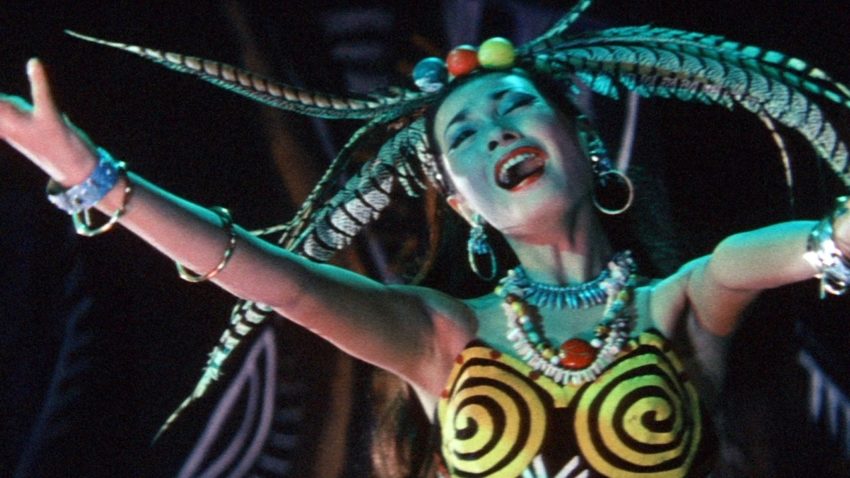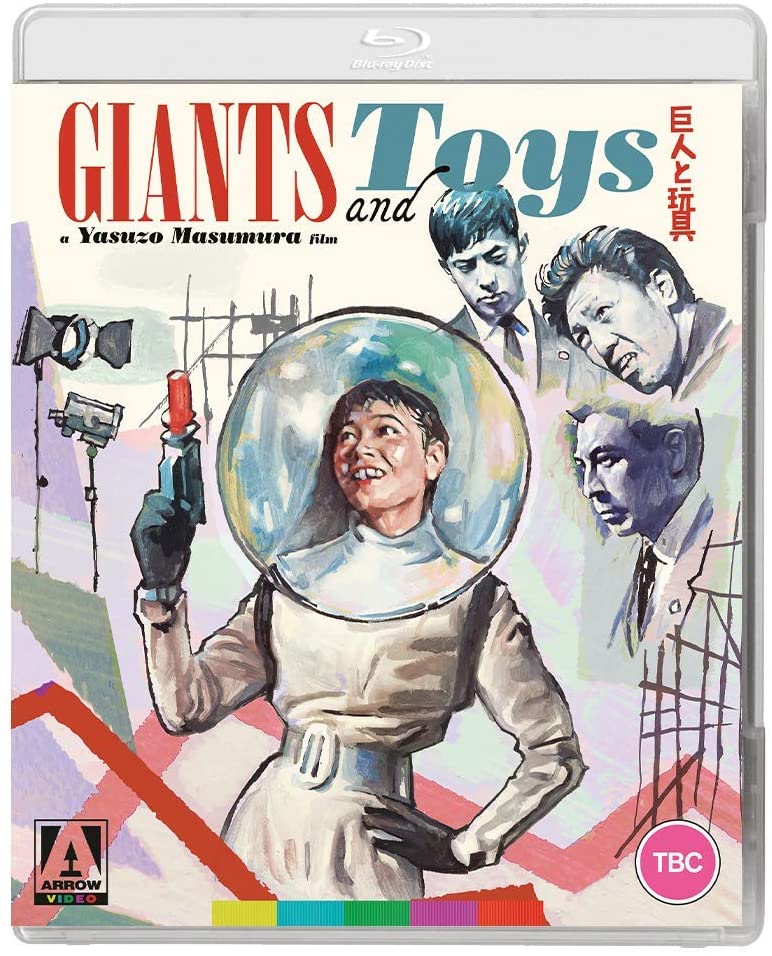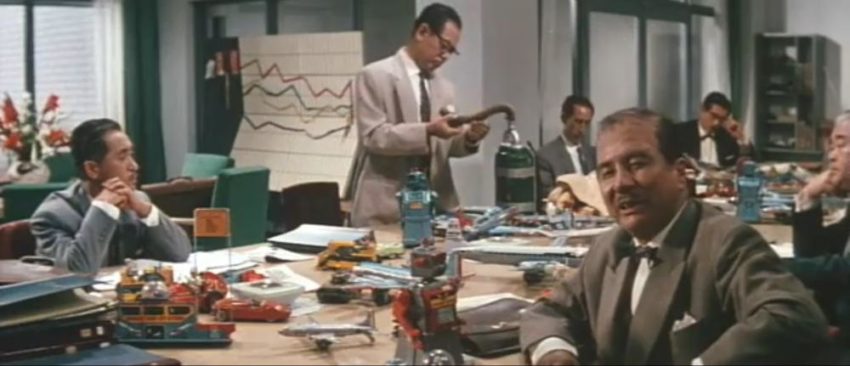Giants and Toys
June 20, 2021 · 0 comments
By Tom Wilmot.

As three caramel companies, World, Giant and Apollo duel for market share, fresh-faced World employee Nishi (Hiroshi Kawaguchi) assists his ambitious boss, Goda (Hideo Takamatsu) in making a star out of the rotten-toothed tomboy Kyoko (Hitomi Nozoe), who is to be the face of their space-themed campaign. As each company’s marketing drive escalates to the point of lunacy, friendships, sanity, and health are all lost in a bid to win the sales war.
A prolific director in his day, Yasuzo Masumura was hot off the back of releasing four films in under a year when he took on what stands to be one of his most important projects, Giants and Toys. The movie, which is overshadowed to an extent by the filmmaker’s more erotically charged works in the sixties, is comfortably one of the most unorthodox Japanese films of its era.

Adapting Takeshi Kaiko’s award-winning “business novel” for the screen with Yoshio Shirasaka, Masumura delivers a damming critique of the Americanised and consumerist-driven Japan that emerged in the post-war years. The ruthless advertising executives of the three caramel companies stop at nothing to outdo competitors and ensure that their product reigns supreme. “To me, they look like caramels,” observes the head of World as he watches the masses of indistinguishable salarymen trudging through the Tokyo streets, demonstrating the detachment from humanity with which these corporate stooges work.
Not all cynicism leads to success. Goda, once a picture of professionalism, is reduced to a blood-coughing retch as he works to advance his utterly unrewarding career. Nishi is the only one who at least tries to retain his dignity as the advertising campaigns grow out of control, yet even he eventually succumbs to the company’s demands, despite witnessing the perversion of his fellow publicists. The fact that such fuss and personal sacrifice is made at the expense of selling caramel is not only humorous but also emphasises the ludicrous nature of a post-war Japanese society that demanded everything of white-collar workers but offered little in return. The film would also prove oddly prophetic – lovers of anime history may recall the infamous “chocolate wars” of the 1960s, as Morinaga and Meiji Seika, two huge candy manufacturers, duked it out in the media by paying for TV slots, filling them with children’s programming, and shoving their own ads into the commercial breaks. After Morinaga passed on a little thing by Osamu Tezuka, Meiji Seika swooped in to sponsor what would become known as Astro Boy.
Giants and Toys was a significant feature in several senses for Masumura, not in the least because it marked the director’s first venture into the relatively new widescreen format. Presented in “Daieiscope” and shot using gloriously rich Agfacolor filmstock, Masumura crams the frame with as much as possible, accentuating the film’s feeling of excess. World’s offices are flooded with loud toys, comically simplistic charts, and frenzied staff, many of whom whizz in and out of the frame. There’s an incredible energy in every scene that only becomes more intense as the rival advertising campaigns become more frantic. The pace of both the editing and dialogue means that the film can sometimes be quite disorienting, a feature that put off many audience members and critics during its financially unsuccessful theatrical run. It was precisely this sense of speed that Masumura hoped to achieve as he railed against the slow-paced characteristics of traditional Japanese cinema. The relentless super-abundance, particularly in the film’s latter stages, means that, surprisingly, its pacing isn’t a world away from that of modern cinema.

Alongside being a vehicle for Masumura’s personal vendetta against traditional methods of Japanese filmmaking, in Giants and Toys, we also find a critique of celebrity culture that remains relevant today. Kyoko’s rapid rise to stardom as she becomes the face of World’s space-age campaign is strikingly similar to the momentary bursts of viral fame we see among social media influencers today. The film takes aim at ephemeral celebrity culture, a point made clear when Nishi comes upon a crying woman, forgotten to the public, having once been World’s poster-girl. He and Goda sink time and money into crafting an appealing public image of Kyoko that couldn’t be further from the truth. Their manipulation of Kyoko somewhat poetically comes back to bite them when the young star begins to revel in her fame and decides to forge a new career of her own. But having lost her individuality to the system, she becomes a manufactured product no different from the sweet caramels she is hired to promote.
In a newly recorded introduction to the film, Japanese cinema expert Tony Rayns notes how staggeringly accurate Masumura’s depiction of rampant consumerism and corporate hysteria remains. He discusses how innovative Giants and Toys was, compared to its contemporaries, and explores the professional relationship Masumura developed with the aforementioned Yoshio Shirasaka, who would pen several more of the director’s features. Earl Jackson, chair professor at Asia University in Taiwan, also features on this Arrow release, delivering a 20-minute video essay in which he delves into the film’s criticisms of Japanese society in general, asserting persuasively that the imperialist aggressions of the Second World War were redirected into the business world.

Giants and Toys can also be enjoyed in the company of Japanese cinema scholar Irene González-López, who takes an analytical approach to Masumura’s film with her audio commentary. Her breakdown of specific scenes provides excellent insight into the director’s visual preferences, as well as explaining why he persevered with certain stylistic decisions despite receiving critical backlash. González-Lopez also offers up interesting nuggets regarding the main stars of the film, specifically Hitomi Nozoe and Hiroshi Kawaguchi, who were an item at the time of production. The former, a well-known singer and dancer, had featured in a few of Masmumura’s films already and would go on to work on three more before eventually leaving the movie scene entirely. She was most definitely cast against type in the role of Kyoko, which is remarkable given how naturally she slips into the character.
Rounding out this release is an extensive written piece from author Michael Raine, whose earlier essay on Giants and Toys, entitled ‘Modernization Without Modernity’ is also highly recommended. Raine provides further context surrounding the film’s production, paying special attention to Daiei’s promotion of young talent in an ever-competitive industry. In many ways, the excesses displayed by the Japanese cinema industry at the time of Giants and Toys’ release are comparable to those of the caramel companies in the movie. An abundance of double-feature programs and inflating budgets led to a mass output of films during the late fifties, which ultimately proved unsustainable and culminated in the slow collapse of the studio system over the next decade.
During one of the more explosive board meetings in Giants and Toys, the stubborn Goda declares that “the media is the dictator, the emperor of the modern age.” If only Yasuzo Masumura knew just how prophetic this seemingly exaggerated statement would be over sixty years later. The fact remains that the film is astoundingly modern in everything from its form to its sentiment, showcasing just how ahead of his time the director was and reinforcing that he’s a Japanese filmmaker whose work is worth exploring.
This well-rounded Arrow Video release features a handful of solid extras that serve as an enticing introduction to the different facets of Masumura the filmmaker, which are sure to encourage interested viewers to do further digging. Revisiting Giants and Toys may serve as a timely intervention to anyone who has felt themselves becoming a slave to consumerism in an age where mass media and communications continue to proliferate. And on that note, caramel, anyone?
Giants and Toys is released in the UK by Arrow Video.
Leave a Reply